Assayer Edward Ruhling’s Presentation Ingot to William Sharon, circa 1869
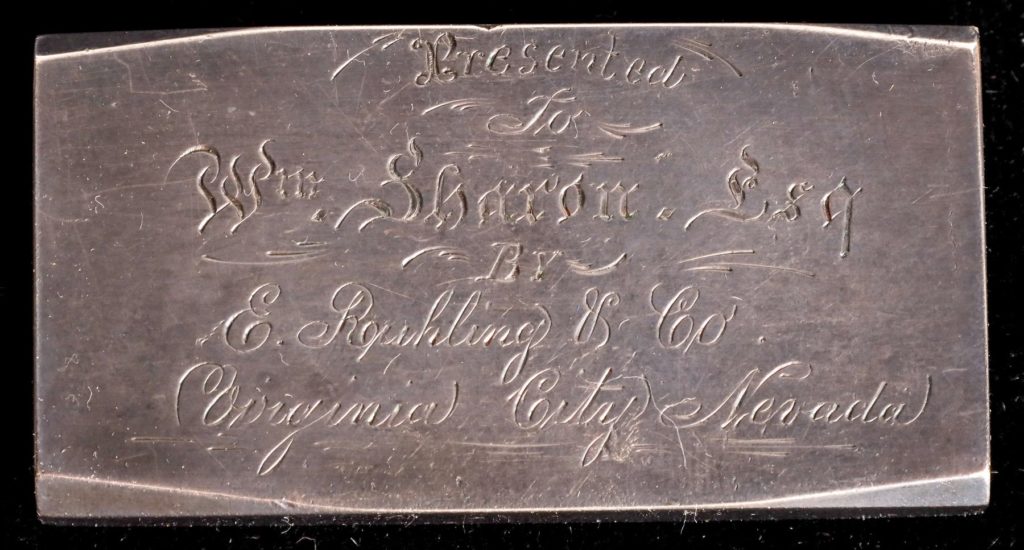
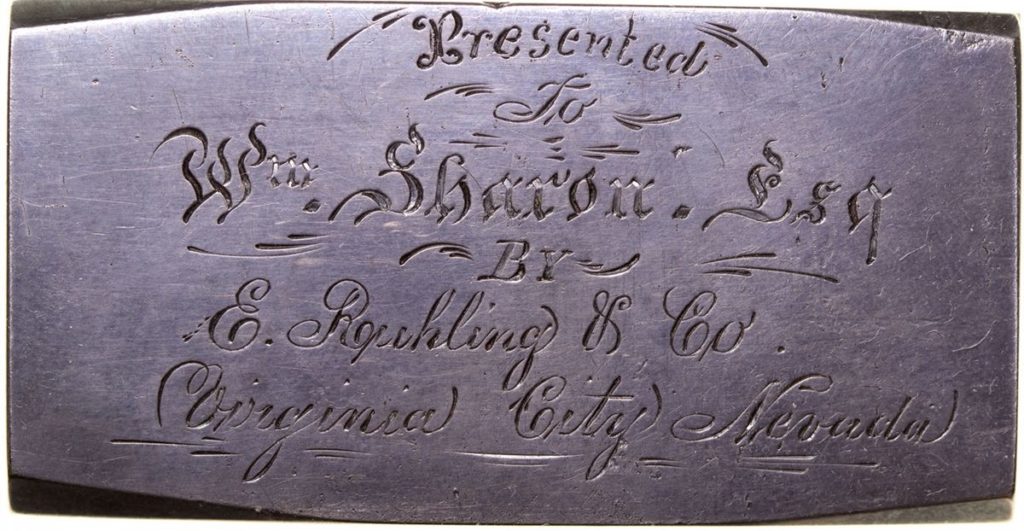
This important silver ingot was first illustrated in the book, The Anatomy of an Ingot (Franklin, 2012, p. 12). It is ornately engraved “Presented to William Sharon, Esq. by E. Ruhling & Co., Virginia City, Nevada.” It measures 2 1/4″ x 1 3/16″ and weighs 4.90 troy ozs. The ingot is perfectly rectangular, with the top and bottom corner edges beveled at the edges. It is blank on the reverse, highly polished throughout, indicative of its importance at the time.
This unique and significant silver ingot was made by Edward Ruhling and engraved by Nye & Co. of Virginia City in 1869, for William Sharon, the Infamous King of the Comstock and commensurate with the creation of the silver spike for the Central Pacific Railroad and the silver hammer for the Virginia & Truckee Railroad. (See biography of William Sharon by Michael J. Makley, 2006)
Edward Ruhling Background
Friedrich Wilhelm Eduard Ruhling was born in Hamburg, Germany in 1832 and arrived at San Francisco in 1850. Little is known about his early life in California which, like so many other pioneers, may have been spent in the goldfields.
Ruhling may have been assayer for the prestigious assay firm Wass, Molitor & Co., a well-known pioneer gold coiner, which later evolved into Wass, Uznay & Co, in 1856. It is documented that he was working at the California Metallurgical Works owned by Wass, Uznay & Warwick by 1858. Ruhling probably worked with and perhaps was trained by the famed assayer and metallurgist, Guido Kustel who was employed during the same period by this firm. By 1859 he was an experienced assayer with Harris, Marchand & Co. in Sacramento, one of the companies represented in the SS Central America gold ingot discovery. While working for Harris, Ruhling was among the first to report (October 1859) on the richness of the Comstock ore, analyzing specimens of “Washoe silver ore” assaying some $4000 per ton.
Grass Valley assayer Melville Atwood was the first to report on the Comstock high grade silver and gold ore on June 27th, 1859. Nevada City assayer J.J. Ott became the second a few days later. Ruhling, at Harris’s Sacramento branch assay office, became the third assayer to report on the rich ore helping set off the great rush to the Comstock silver and gold deposits. Motivated by his own assay analysis of the Comstock ore, Ruhling quickly left Harris to set up his own assay office in Virginia City in mid-1860 with Joseph Trench. Harvey Harris soon followed his former employee, Ruhling to the Comstock and eventually set up three assay offices in the Nevada Territory.
The western assay business involved a variety of precious metals trading transactions. Dore, the melted product of the reduction of ores at a mill, mainly a mixture of gold and silver, was brought to the assayer for valuation. He, in turn, would pay the client in gold coin, return new ingots to the client, or ship the dore to a bank, smelter, or Branch Mint per the owners instructions. Being involved in converting ingots to cash, essentially a banking function, the western assayer was at the center of commerce during these early days. Entering the banking business was a logical next step for Ruhling.
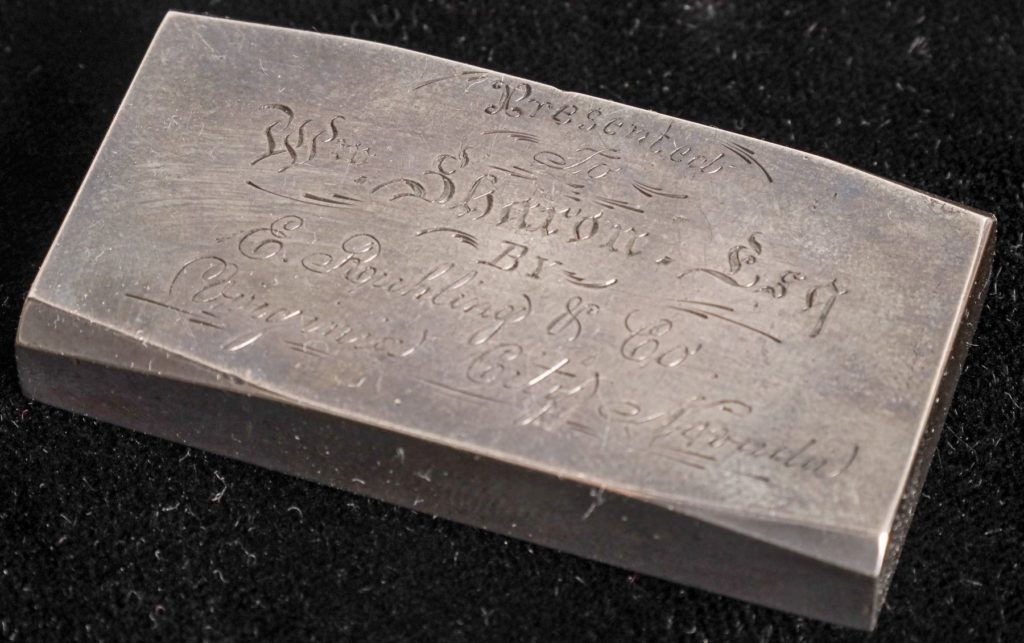
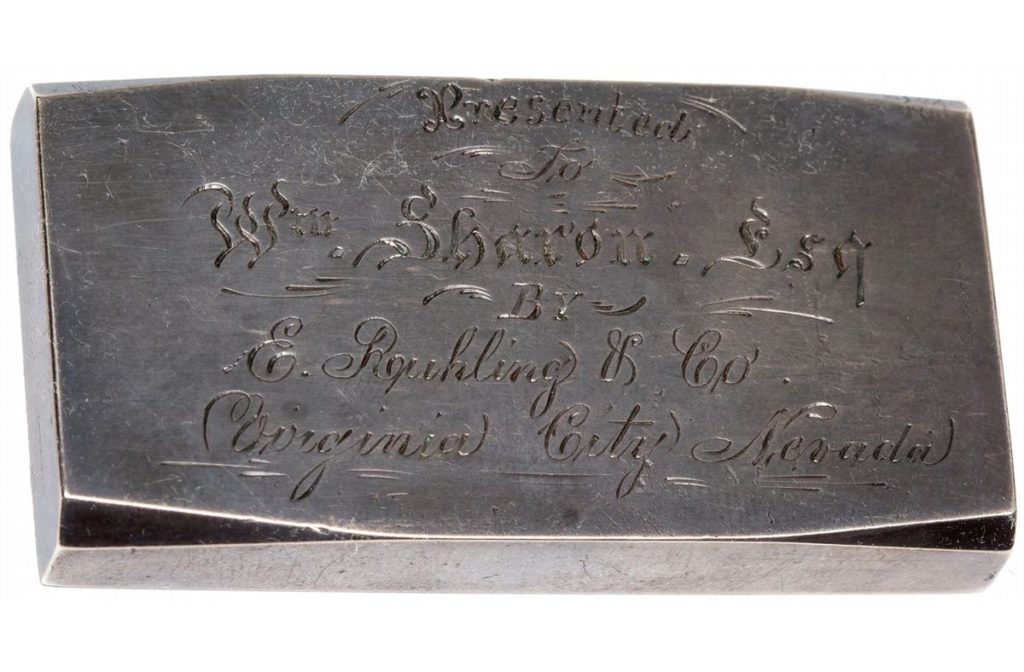
With his partner H. V. S. McCullough, he established one of the early Comstock banks in 1862 associated with their assaying business. Over time, Ruhling expanded his business interests setting up branch assay offices in Gold Hill and Hamilton, Nevada. In 1871 he sold out to his partner McCullough and returned to San Francisco working as an assayer and joined the Assay Department at the San Francisco Mint by 1878. Ruhling died in San Francisco at the age of 66 in 1898.
Ruhling on the Comstock
As one of the pioneer assay firms on the Comstock, Ruhling quickly took control of a significant portion of the assay business after he opened his office at Virginia City in 1860. When the Bank of California opened their doors in that location with William Sharon at the helm in 1864, the bank required precise information on the mining interests to which they were loaning money. Ruhling was the “go-to” assayer for Sharon, keeping him abreast of the values of the mines and production, allowing him to make informed decisions on high risk ventures. Over the years, the two became close friends, according to several sources.
Sharon had envisioned a railroad link from the Comstock to the Carson River ore mills, ultimately connecting with the Central Pacific Railroad (CPRR) at Reno. The Virginia & Truckee Railroad (V&T RR) became the main artery from the Comstock to the mills and the CPRR, with Sharon leading the venture. Sharon and William Ralston (Bank of California president) controlled the mills through their privately owned Union Mill and Mining Co. When the first link of the V&T RR to the Carson River mills was completed in November, 1869, a special silver hammer was made for driving the last spike: “At Nye & Co.’s jewelry store, Virginia, this morning, we saw the hammer being finished there with which the last spike of the Virginia and Truckee Railroad is to be driven, in about ten days from now when the final celebration will take place. This hammer is of solid silver bullion, weighing 43 ounces, cast by Ruhling & Co., who furnished the bullion, in which each mine on the Comstock is represented. It was forged by Haskins & Co., blacksmiths, and is being polished off and appropriately engraved by Nye & Co.” (Gold Hill News 11/13/1869) Thus the Ruhling & Co., Sharon and Bank of California enterprises were closely woven, forming a unique bond. By 1871 Sharon and Ralston controlled most of the mines and mills on the Comstock making them the two most powerful financial figures in the West.
This ingot, most likely was engraved by the same Nye & Co. Jewelers as the Ruhling silver hammer, has been in the same family collection for more than 50 years. Other important Sharon personal artifacts left the family over time, including his personal gold quartz engraved walking cane now at the Bank of California Museum in San Francisco, and the Sharon document archive, now thoroughly distributed, which included deeds, checks and other documents.
Dating the Ingot
The Ruhling-Sharon ingot probably dates to the 1869 period, at a time when Ruhling also made the ceremonial silver hammer for the opening of the V & T RR and the silver spike for the CPRR. Ruhling was asked to produce the silver spike for the CPRR completion presentation at Promontory Point, Utah taking place on May 10, 1869. The “Nevada silver spike” was made at the request of Nevada Railroad Commissioner Fred A. Tritle, containing 25 ounces of silver. It assayed 942 fine silver and 050 fine gold. A leftover piece was given to the editor of the Territorial Enterprise, Mr. Goodman, the man who hired the famous Sam Clemens (aka Mark Twain) to write for that paper, etching his name in history. Another piece was given to Alf Doten, Editor of the Gold Hill News, who wrote in his Journal on May 7: “After I got back from the Hill I went to Ruhling & Cos office, Virginia, B Street, & got a little piece of the “last spike” – the silver spike of Nevada, that finishes the great railroad – the spike was made at Virginia City and sent to the front yesterday – the spike was 4 or 5 inches too long – & this was part of what was cut off – got about a half ounce of it – David Sampson, the young assayer at Wiegand’s assay office gave me a small, brick of silver bullion this PM, worth about $6.” The Nevada Silver Spike today is owned by the Museum of the City of New York (see Tents of the Golden Spike, by our friend Bob Spude.) The Virginia & Truckee Railroad silver hammer was given by the Yerington family to the Mackay Museum in Reno in 1929. Its whereabouts today is unknown.
Sharon gave two important speeches in Virginia City and Gold Hill in early October, 1869 pressing the importance of the new railroad. On November 12, as the railroad neared final completion, he and Senator Jones made speeches of the upcoming successes for miners with the completion of the Railroad. That day, he wrote in his journal: “…Gold Hill – 1PM the track layers finished the railroad to Crown Point Ravine, & at 5PM in presence of big crowd the two construction trains passed over the big trestle bridge – brass band playing on first locomotive – flags flying everywhere – big gun at Ft Homestead firing, whistles all blowing, people cheering, and hell of a noise generally – After both trains passed over, speeches were made by JP Jones and Sharon and lots of cheers were given for RR & its successful projectors and all the most prominent persons connected with it – Then there was a huge lot of champagne, lager, etc. drank…” This would have been the time that Ruhling presented the ingot to Sharon in recognition of his great feat, the completion of the Virginia & Truckee Railroad.
Summary
This choice presentation ingot was made by Edward Ruhling, an assayer at two of the great California Gold Rush assay firms and a key Nevada assayer, for presentation to one of the West’s most powerful men upon completion of the Virginia & Truckee Railroad. This unique ingot personally represents two of the most significant men of the early Comstock Mining boom.
[06/2023] https://holabirdamericana.liveauctiongroup.com/William-Sharon-Presentation-Ingot-E-Ruhling-Co-Virginia-City-Nevada-165230_i49117388 ($37,500)
[09/2014] https://holabirdamericana.liveauctiongroup.com/William-Sharon-Presentation-Ingot-E-Ruhling_i20352921 (Passed)
6.13 oz CA – San Francisco,William Sharon Dinner Ingot
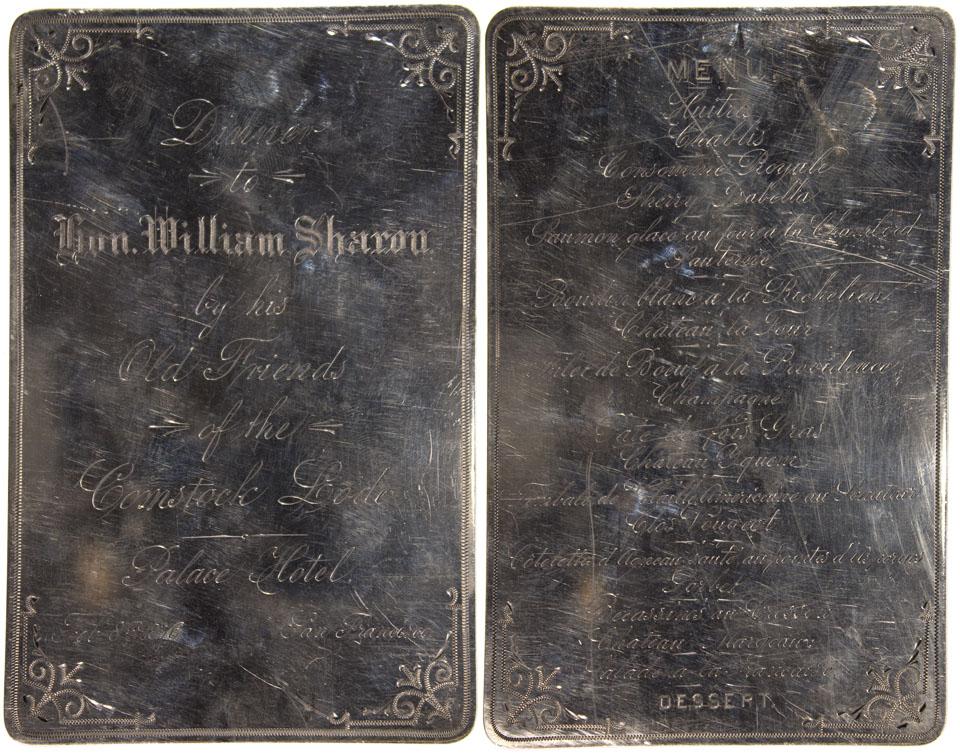
Introduction
The William Sharon silver dinner plate ingots were first described by us almost a decade ago. Lost to history for over a hundred years, one showed up in an eastern family archive. After the sale of the first, a second surfaced within a couple of years. Then, perhaps five years ago, a crumpled up, severely damaged specimen appeared on ebay. It had no person’s name engraved on it, and was suspected of being a trial or sample from Shreve’s silver shop in San Francisco. The buyer, a serious Comstock collector and descendent of one of Nevada’s famous Comstock financiers, had the piece restored as best as possible. Recently, a second example appeared in an east coast family archive, which is the specimen described for this lot. It also has no person’s name engraved on it. I immediately questioned the two, as it appeared from the two we had, plus three more in institutional (or family) hands that all had names engraved on them. So I called one of the family members of one of the attendees to ask if we could closely inspect their prized family heirloom up close and personal. I was able to compare the two pieces, the one offered here, and the heirloom, side by side. There is absolutely no doubt whatsoever that these two ingots were made by the exact same hand. They are identical down to the nth degree, something that is not possible to do from published photographs. This raised an important question – Why would these ingots exist without a name engraved on the face? Some answers are found below.
Description
Large presentation ingot for a celebration honoring William Sharon “by his old friends of the Comstock Lode,” 1876. This ingot was made for all-out surprise celebration for Sharon and his friends. This ingot is blank where the others I have seen have the attendees name engraved at the bottom of the obverse of the ingot. Nineteen of these ingots were reportedly made for each of the attendees and a 20th for William Sharon. This ingot comes from the family of Colonel James Duffy of Pennsylvania. Duffy was not listed as one of the attendees at the dinner, though at least two of the attendees were from the New York area. 6.13 Troy ounces. Approximately 6.25” X 4” and 1+ mm thick.
The Story
The party was at the Palace Hotel, built by Sharon’s old boss, William Chapman Ralston. Ralston had committed suicide several months earlier after the Bank of California’s failure in 1875. It was at one time the largest and most powerful bank in the United States. The Bank had made it through the failure with the help of Sharon and friends. Reports said the affair had all the accoutrements of an inaugural ball but was exceptionally private. Flowers were everywhere. The Palace Hotel manager, Mr. Warren Leland, was told to spare no expense, according to an article that appeared in the “San Francisco Examiner” the next day. It reported:
“It is fair to presume that the grand dinner spread in honor of William Sharon, in the Palace Hotel, on Tuesday Evening, has never been equaled in good taste or elegant surroundings on this continent. An enthusiast might say that ‘it was fit for the gods’ and it is doubtful whether there would be an exaggeration in such an assertion… No public announcement of the intended gathering was given, and Mr. Sharon was ignorant of the arrangements until he was escorted into the banquet hall.”
The paper went on to report the attendees were all old friends of Sharon’s “long before he found the means to build up a fortune.” Twenty men sat at a single table. D. O. Mills, sat at one end, and General John F. Miller, of the Alaska Commercial Company, sat at the other. Judge Heydenfeldt was seated at Miller’s left. Seated down the two sides were people who will be a familiar lot to those students of early Comstock history: Thomas Bell, William Lent, and W. Alvord, all part of the original Gould & Curry Company; William Morris Stewart, champion Comstock lawyer and later Senator; Wood A. Head and Bob Morrow, all early claim stakers on the Comstock from Nevada City and Grass Valley; J. Sahaw, J. Skae, both mine superintendents on the Comstock (Morrow was also supt. of the Savage); and G. S. Dodge, A. Gansl, A. Selover. Sta. Marina, D. L. Bliss and Steinhart. Apparently, while the men celebrated and told stories to one another, a band played nearby. There were no speeches; the party was a simple celebration of friendship in its grandest form.
The ingots were so exciting to the men and news media, that they were described in detail in the “Examiner”. It reported that “At each plate were glasses for eight different kinds of wine. The napkins were folded flat, and on each was a delicate bouquet. Beneath the napkin was a bill of fare engraved on solid silver, dug from the Comstock lode, and highly polished. These measured about 6 1/4 by 4 1/4 inches… On the front of this novel and costly affair was inscribed in ornamental text and script…” words about the celebration and the menu fit for a king. An observer “laughingly remarked… Everybody went away from the dinner with a silver brick in his hat.” Layout- put in bold- maybe on a separate line
The silver ingot was the perfect gift for all the attendees. Nearly all the men were heavily involved in mining at one time. Most were on the Comstock at the beginning. A very fresh story would have been shared about silver ingots, told by Senator Wm. Morris Stewart. Stewart had headed a bunch of investors along with John P. Jones in the mines at Panamint, California. In 1875 they pulled out a million in silver, but were acutely aware of highwaymen just waiting for the bullion laden wagons to come down the treacherous canyons out of the Panamints. The mountains were so rugged, that there is about 6000 feet of relief in just over a mile of horizontal distance. Even the mighty Wells Fargo & Co. would not dare to establish an express office there for fear the risk of robbery was too high. Stewart related “They said they wouldn’t run any risks at Panamint, not with that bunch of highwaymen lying around just waiting to swoop down and gobble up every dollar in sight.” Stewart needed a plan. He said, “Finally I hit on a scheme. I had some moulds made in which a ball of solid silver could be run weighing 750 pounds. Then I began smelting the ore, and I ran out enormous cannon balls of the precious stuff that could have bombarded a battleship. When the road agents saw what I was doing, their eyes stuck out of their heads. They acted as though I had cheated them out of property… .” It was a very clever plan indeed.
There are many incidences surrounding William Sharon’s rise to power. Sharon was the manager of the Bank of California in Virginia City who had been handpicked by Ralston. He was a man who knew failure, and Ralston felt Sharon was not likely to want to fail again. Ralston told his Board that Sharon was the best poker player he had ever known. Ralston knew Sharon could beat any of the Board at any game of business they chose, so that’s why Ralston thought Sharon should head the Virginia City office. He would be the best manager of money and bank affairs they could every hope for.
There was a crash on mining stocks in May, 1872, which persisted until 1875. Another stock panic hit in August, 1875, which crushed the Bank of California, once considered “the strongest banking institution on the Pacific Coast.” The great bonanzas of the Crown Point and others were only temporary fixes in a stock market that was wild with excitement and activity. There was a run on the Bank of California on August 26, 1875. They closed on the 26th. Ralston had surrendered the Palace Hotel, one of his jewels which was not yet finished, to Sharon on the 25th. He had absolute confidence in Sharon. George Lyman wrote in Ralston’s Ring, “They were closer than brothers”. Ralston surrendered all of his personal property to the Bank for the benefit of the depositors. But he was deceived. That day, Ralston had not a friend, as the entire Board turned against him, and left the bank in resignation. He would never return. Mills was instructed to tell Ralston of his dismissal, which was done the next day. In the afternoon, he walked into the ocean and never came out alive. In the ensuing crash, the value of the mines of the Comstock shrunk to one thirtieth of their value that they had been on Jan 1, 1875. D. O. Mills, the first president of the Bank of California, when it was organized in 1864, became president once again, and secured the funding necessary for the Bank’s reopening, which was on October 2. Sharon was a huge asset, tying up loose ends in Nevada and San Francisco. The stock exchanges in San Francisco also closed because of financial panic, reopened on October 5. The Bank went on to great success and is alive today. Sharon also took over and managed Ralston’s estate for his widow and children.
Summary
This ingot is important not only because of its rarity and of its presentation value to William Sharon, but because of what it represents. It is a remnant of an important turning point in California financial history, recognizing the great mines of the Comstock, the great bankers of California, and the ingenuity of American financiers in general – all at once. There would have been sad discussion of Ralston’s tragedy, but happiness abounded at that dinner at the success of the Palace Hotel, just completed, and of Sharon’s election to the Senate over his bitter rival James G. Fair, one of the Comstock kings. They would have discussed the old times on the Comstock in 1859-60, and their luck in California during the Gold Rush.
Although this particular ingot is blank, it is unquestionably authentic because it is identical in every way to those I have seen previously (we’ve never published a detailed photograph of these ingots.) So the question becomes, why is there a blank ingot in existence? It could simply have been an item given to those who may have donated to Sharon’s California Senatorial campaign, or the Duffy family is in error and a different relative actually attended the dinner. Another scenario is that Duffy, or the holder of this ingot, received it as a late fill-in for one of the New York attendees, such as A. Gansl or one of the others. The latter scenario seems more likely.
Regardless of the lack of an engraved name, this ingot remains one of the great silver presentation pieces of the nineteenth century. It encompasses everything about the nineteenth century West – one of the great Comstock financiers and bankers, a celebration of mining in the West and the incredible splash that the wealthy used at the time. This is one of three in excellent condition known today that have changed hands publicly, though one of the three has a hole in it. It is a treasure whose appearance is not likely to be duplicated anytime soon.
[06/2011] https://www.icollector.com/CA-San-Francisco-William-Sharon-Dinner-Ingot_i10678732 ($24,675)
[08/2013] https://www.icollector.com/William-Sharon-Dinner-Ingot_i16986991 ($16,730)
[09/2017] https://www.icollector.com/California-San-Francisco-William-Sharon-Silver-Dinner-Ingot_i27907324 ($11,750)
Other examples have names engraved of the guests on the menu:
George S. Dodge – Geo. S. Dodge, name engraved at the bottom of the obverse of the ingot. General George Sullivan Dodge was a decorated Civil War veteran, who was brought to the West Coast about 1871 to manage the large new silver company in Eureka, the Eureka Consolidated. The mine was so rich that it rivaled the best of the Comstock, ultimately producing over $20 million from 1873 to 1906 alone. Dodges office was in San Francisco, right in the center of the Montgomery Street business section (Bank of California, etc.) where most of the financial ends of the Comstock mining barons took place. Dodge appears to have been appointed the first president of the Company, with the attendant job of getting the mine into profitable and large scale production. He was also associated with Candelaria, Cherry Creek and Virginia City mining operations. He and his wife moved across the Bay, where he died in Oakland in 1881.
[02/2014] https://www.icollector.com/George-S-Dodge-Sharon-Ingot-_i18831453 ($14,937)
[10/2016] https://www.icollector.com/William-Sharon-Silver-Ingot-to-Civil-War-General-Nevada-Mining-Capitalist-George-Sullivan-Dodge_i25648972 ($13,310)
Unique William Sharon Silver Ingot – small tray – modified
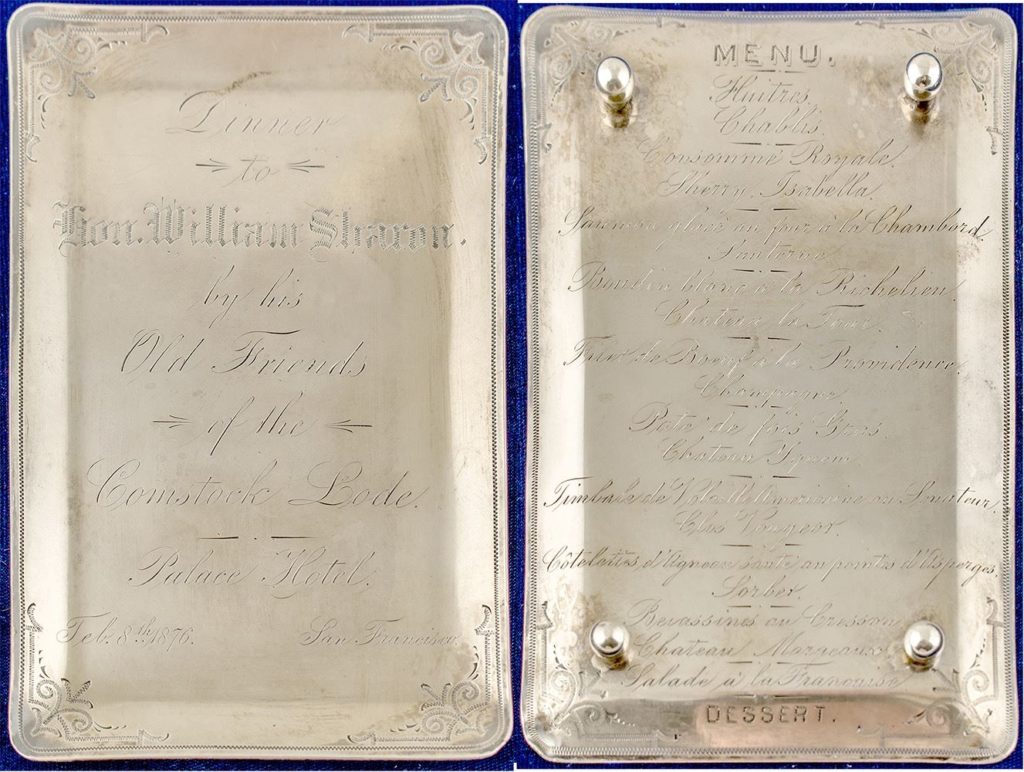
This is a large presentation ingot for a celebration honoring William Sharon “by his old friends of the Comstock Lode,” 1876. Nineteen of these ingots were reportedly made for each of the attendees and a 20th for William Sharon. It is 6.13 troy ounces. Approximately 6.25″ x 4″ and 1+ mm thick. What makes this ingot unique is that it has been professionally altered in the past to act as a small tray with four small ball feet and raised edges.
Imagine having this on your desk holding your business card to hand to someone entering your office. Impressive! The event as described by the San Francisco Examiner, ” It is fair to presume that the grand dinner spread in honor of William Sharon, in the Palace Hotel, on Tuesday Evening, has never been equaled in good taste or elegant surroundings on this continent. An enthusiast might say that ‘it was fit for the gods…’” The ingots were so exciting to the men and news media, that they were described in detail in the Examiner, “At each plate were glasses for eight different kinds of wine. The napkins were folded flat, and on each was a delicate bouquet. Beneath the napkin was a bill of fare engraved on solid silver, dug from the Comstock lode, and highly polished. These measured about 6 1/4 by 4 1/4 inches… ” Although no name is listed, “it is unquestionably authentic because it is identical in every way to those I have seen previously (and we’ve never published a detailed photograph of these ingots.)”, Fred Holabird. Includes information that goes into much further depth! NO RESERVE City: San Francisco State: Nevada Date
[05/2016] https://www.icollector.com/Unique-William-Sharon-Silver-Ingot_i24628403 ($4,800)
[10/2018] https://www.icollector.com/Unique-William-Sharon-Silver-Ingot_i31463975 ($4,350)
